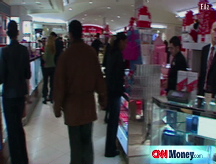Sharp decline seen in holiday shoppers
Retail group says 2008 should be the weakest year since it began tracking activity.
NEW YORK (CNNMoney.com) -- The volume of shoppers is expected to decline sharply during the 2008 holidays due to such factors as the financial market meltdown and a shorter season, according to a retail industry survey released Wednesday.
ShopperTrak RCT, a retail research firm, predicted store traffic would decrease 9.9% from last year. It said overall retail sales would rise just 0.1%.
Both figures are the lowest since the company began compiling the data in 2001.
"Due to numerous factors that retailers can't control, 2008 has been a challenging year and it seems this pattern will continue throughout the crucial holiday shopping season," said Bill Martin, ShopperTrak's co-founder..
The gloomy predictions are a result of a "perfect storm" in late 2008, as the financial market weakened, the presidential election slowed shopping, and the after-effect of the summer surge in gas prices kept people from driving to the stores.
ShopperTrak said it has reported a pattern of slowed consumer shopping in the weeks before and after each Congressional or presidential election since 2002.
In the 2007 holiday season, retail sales increased 2.5% while total traffic fell 2.7% from the previous year.
The 2008 calendar shifts to a shortened shopping period between Thanksgiving and Christmas, eliminating one shopping weekend. The 2007 holiday shopping season was the longest possible, at 32 days.
"This means retailers should see some strength earlier in the season on Black Friday due to pent up demand, but also means procrastinators may be caught by surprise late in (the) year," Martin said in a statement.
ShopperTrak said this year closely resembles 2002, which also had a shortened 27-day holiday shopping period, a weak economy and a Congressional election.
According to ShopperTrak, in 2002 enclosed mall traffic averaged a 2.8% year-over-year decline each week in the month before the election, and in the weeks after the election that figure jumped to 3.9% through the holiday shopping season.
The top ten traffic days will account for almost 35-38% of all traffic during the holiday season, according to ShopperTrak. The top three dates are: Nov. 28, which is the Friday after Thanksgiving; Dec. 20, the Saturday before Christmas; and Dec. 26, the day after Christmas. ![]()


